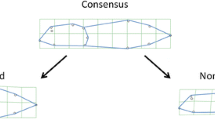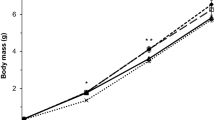Abstract
Predator-induced defenses can result from non-contact cues associated with the presence of a feeding predator; however, the nature of the predator cue has not been determined. We tested the role of two non-contact cues, metabolites of digestion of conspecific prey released by the predator and alarm pheromones released by attacked conspecific prey, in the development of inducible defenses by exposing pinewoods tree frog (Hyla femoralis) tadpoles to non-lethal dragonfly (Anax junius) larvae fed either inside experimental bins or removed from the bins for feeding to eliminate alarm pheromones. The costs associated with the development of the induced morphology were also investigated by providing the tadpoles with two food levels intended to provide adequate or growth limiting resources. The generalized morphological response of H. femoralis tadpoles to predators included the development of bodies and tails that were both deeper and shorter, smaller overall body size, and increased orange tail fin coloration and black tail outline. Metabolites of digestion were sufficient to initiate development of inducible defenses; however, the combination of metabolites and alarm cue resulted in a greater response. Furthermore, growth and development were slowed in tadpoles that expressed the induced morphology; however, this growth cost was insufficient to preclude the development of the induced morphology when food resources were low. These results indicate that two aspects of the indirect predator cue work together to trigger a morphological anti-predator response.


Similar content being viewed by others
References
Alford RA, Harris RN (1988) Effects of larval growth history on anuran metamorphosis. Am Nat 131:91–106
Anholt BR, Werner E, Skelly DK (2000) Effects of food and predators on the activity of four larval ranid frogs. Ecology 81:3509–3521
Babbitt KJ (2001) Behaviour and growth of southern leopard frog (Rana sphenocephala) tadpoles: effects of food and predation risk. Can J Zool 79:809–814
Bookstein FL (1991) Morphometric tools for landmark data: geometry and biology. Cambridge University Press, Cambridge
Caldwell JP (1982) Disruptive selection: a tail color polymorphism in Acris tadpoles in response to differential predation. Can J Zool 60:2818–2827
Gosner K (1960) A simplified table for staging anuran embryos and larvae with notes on identification. Herpetologica 16:183–190
Harvell CD (1986) The ecology and evolution of inducible defenses in a marine bryozoan: cues, costs, and consequences. Am Nat 128:810–823
Harvell CD (1990) The ecology and evolution of inducible defenses. Q Rev Biol 65:323–340
Kornerup A, Wanscher JM (1961) Methuen handbook of color. Methuen, London
Laurila A, Kujasalo J, Ranta E (1997) Different antipredator behaviour in two anuran tadpoles: effects of predator diet. Behav Ecol Sociobiol 40:329–336
McCollum SA, Leimberger JD (1997) Predator-induced morphological changes in an amphibian: predation by dragonflies affects tadpole shape and color. Oecologia 109:615–621
McCollum SA, Van Buskirk J (1996) Costs and benefits of a predator-induced polyphenism in the gray tree frog Hyla chrysoscelis. Evolution 50:583–593
Moran NA (1992) The evolutionary maintenance of alternative phenotypes. Am Nat 139:971–989
Parejko K, Dodson S (1990) Progress towards characterization of a predator/prey kairomone: Daphnia pulex and Chaoborus americanus. Hydrobiologia 198:51–59
Petranka J, Hayes L (1998) Chemically mediated avoidance of a predatory odonate (Anax junius) by American toad (Bufo americanus) and wood frog (Rana sylvatica) tadpoles. Behav Ecol Sociobiol 42:263–271
Petranka JW, Kats LB, Sih A (1987) Predator-prey interactions among fish and larval amphibians: use of chemical cues to detect predatory fish. Anim Behav 35:420–425
Relyea RA (2000) Trait-mediated indirect effects in larval anurans: reversing competitive outcomes with the threat of predation. Ecology 81:2278–2289
Relyea RA (2001a) The lasting effects of adaptive plasticity: predator-induced tadpoles become long-legged frogs. Ecology 82:1947–1955
Relyea RA (2001b) Morphological and behavioral plasticity of larval anurans in response to different predators. Ecology 82:523–540
Relyea RA (2001c) The relationship between predation risk and antipredator responses in larval anurans. Ecology 82:541–554
Relyea RA (2002) Costs of phenotypic plasticity. Am Nat 159:272–282
Relyea RA, Werner EE (2000) Morphological plasticity in four larval anurans distributed along an environmental gradient. Copeia 2000:178–190
Semlitsch RD (1987) Interactions between fish and salamander larvae: costs of predator avoidance or competition? Oecologia 72:481–486
Semlitsch RD, Scott DE, Pechmann JHK (1988) Time and size at metamorphosis related to adult fitness in Ambystoma talpoideum. Ecology 69:184–192
Skelly DK (1997) Tadpole communities: pond permanence and predation are powerful forces shaping the structure of tadpole communities. Am Sci 85:36–45
Skelly DK, Werner EE (1990) Behavioural and life-historical responses of larval American toads to an odonate predator. Ecology 71:2313–2322
Smith DC (1987) Adult recruitment in chorus frogs: effects of size and date at metamorphosis. Ecology 68:344–350
Smith DC, Van Buskirk J (1995) Phenotypic design, plasticity, and ecological performance in two tadpole species. Am Nat 145:211–233
SPSS (2000a) SPSS user’s guide release 10.1. SPSS, Chicago
SPSS (2000b) Systat user’s guide release 10.0. SPSS, Chicago
Stauffer H-P, Semlitsch RD (1993) Effects of visual, chemical and tactile cues of fish on the behavioural responses of tadpoles. Anim Behav 46:355–364
Tabachnick BG, Fidell LS (1996) Using multivariate statistics, 3rd edn. Harper Collins, New York
Tarr TL (2000) Patterns of larval amphibian and aquatic insect distribution: effects of hydroperiod. Master’s thesis. University of New Hampshire, Durham
Van Buskirk J (2000) The costs of an inducible defense in anuran larvae. Ecology 81:2813–2821
Van Buskirk J, Arioli M (2002) Dosage response of an induced defense: how sensitive are tadpoles to predation risk? Ecology 83:1580–1585
Van Buskirk J, McCollum SA (1999) Plasticity and selection explain variation in tadpole phenotype between ponds with different predator composition. Oikos 85:31–39
Van Buskirk J, Relyea RA (1998) Selection for phenotypic plasticity in Rana sylvatica tadpoles. Biol J Linn Soc 65:301–328
Van Buskirk J, Yurewicz KL (1998) Effects of predators on prey growth rate: relative contributions of thinning and reduced activity. Oikos 82:20–28
Van Buskirk J, McCollum SA, Werner EE (1997) Natural selection for environmentally induced phenotypes in tadpoles. Evolution 51:1983–1992
Werner EE (1991) Nonlethal effects of a predator on competitive interactions between two anuran larvae. Ecology 72:1709–1720
Werner EE (1992) Competitive interactions between wood frog and northern leopard frog larvae: the influence of size and activity. Copeia 1992:26–35
Werner EE, Anholt BR (1993) Ecological consequences of the trade-off between growth and mortality rates mediated by foraging activity. Am Nat 142:242–272
Wilbur HM, Semlitsch RD (1990) Ecological consequences of tail injury in Rana tadpoles. Copeia 1990:18–24
Wright AH, Wright AA (1995) Handbook of frogs and toads of the United States and Canada. Comstock, Ithaca, New York
Zar JH (1996) Biostatistical analysis, 3rd edn. Prentice-Hall, New Jersey
Acknowledgements
This manuscript was improved by suggestions from M. Baber, J. Haney, A. McCollum, J. Taylor, and an anonymous reviewer. We thank M. Baber for collecting the pinewoods tree frog tadpoles and S. Sower for providing access to well water.
Author information
Authors and Affiliations
Corresponding author
Rights and permissions
About this article
Cite this article
LaFiandra, E.M., Babbitt, K.J. Predator induced phenotypic plasticity in the pinewoods tree frog, Hyla femoralis: necessary cues and the cost of development. Oecologia 138, 350–359 (2004). https://doi.org/10.1007/s00442-003-1412-3
Received:
Accepted:
Published:
Issue Date:
DOI: https://doi.org/10.1007/s00442-003-1412-3




